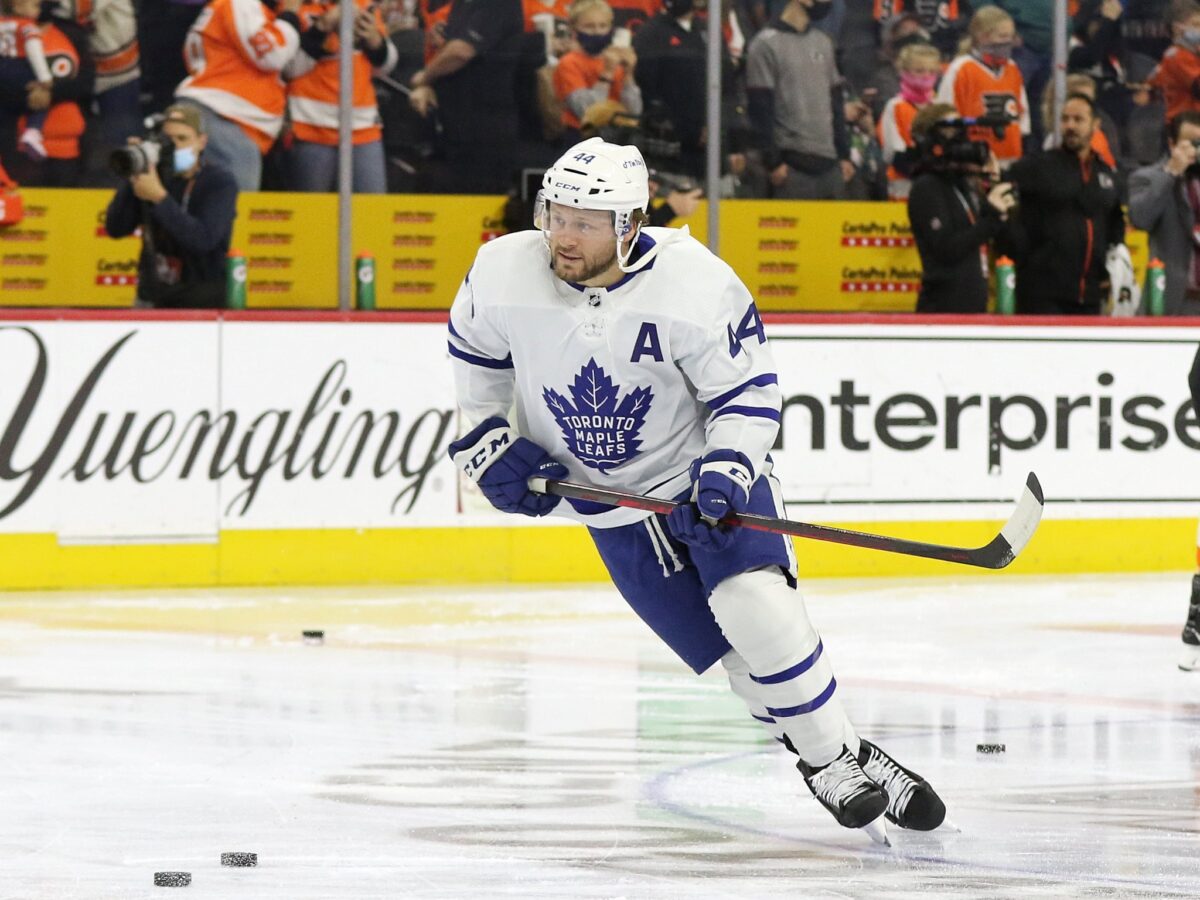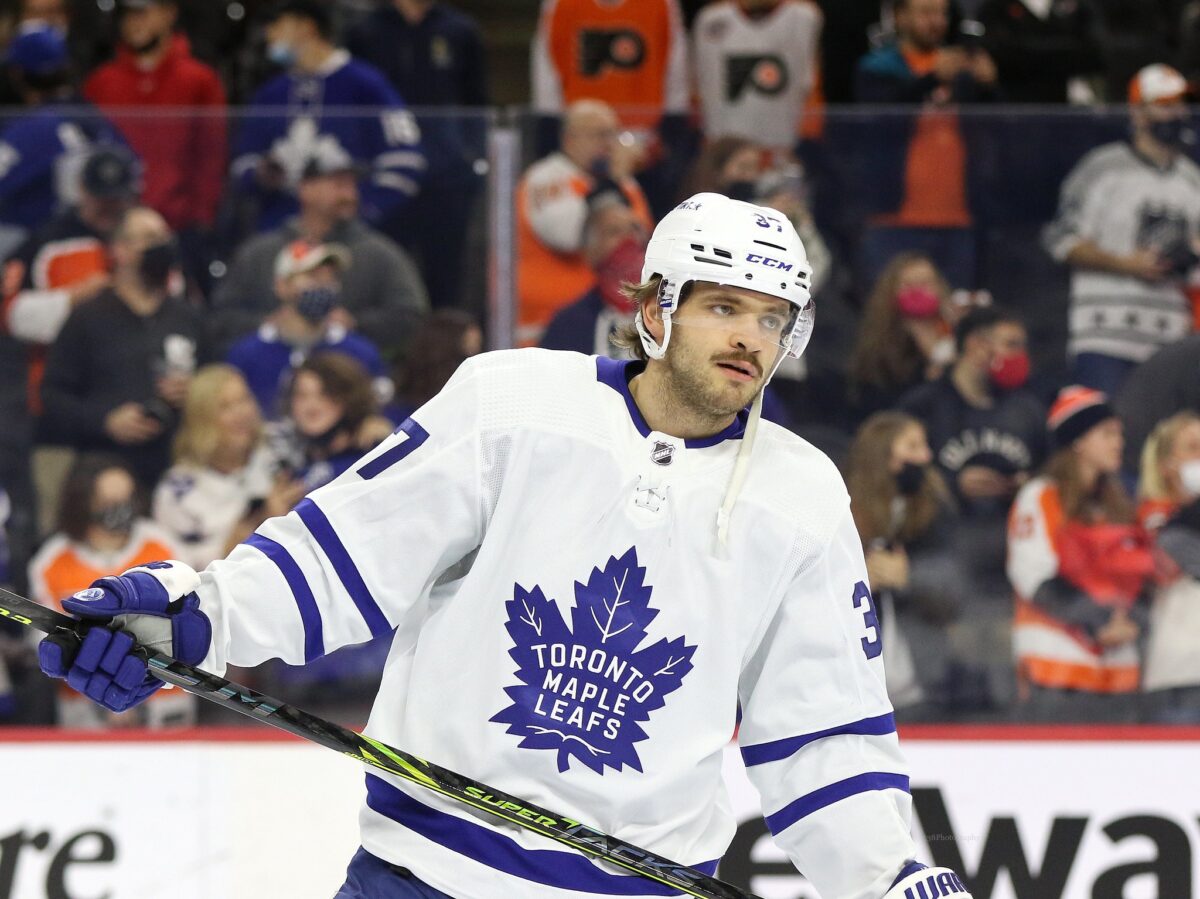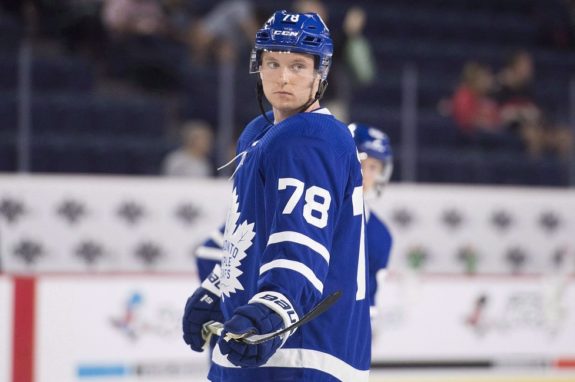If most Toronto Maple Leafs’ fans were asked to rank the Maple Leafs’ defensemen in order of their value to the team, there’s little doubt Morgan Rielly would be ranked first; and, perhaps, Jake Muzzin or T.J. Brodie would be ranked second. Perhaps that’s true for most valuable; however, engaging advanced analytics suggests that another defenseman leads the team in most categories and should be in the conversation of value to the team.
Related: Maple Leafs’ Trivia: Do You Know Your Team’s 2020-21 Statistics?
That defenseman is Rasmus Sandin. If the question of most valuable were amended to a question that asks what Maple Leafs’ defenseman has been best in the role assigned him, it’s easier to see the value Sandin brings to the team as well as the potential he has for the future.

In this post, we’re going to employ some simple advanced analytics to suggest that, both offensively and defensively, a strong argument can be made that Sandin ranks as one of the team’s best rear guards.
The Analytics That We’ve Used to Evaluate Maple Leafs’ Defensemen
In this post, we’re using the following “on-ice” statistics as they apply to five-on-five hockey per 60-minutes played. Here’s how Sandin ranks among Maple Leafs’ defensemen in each of six categories for both offense and defense.
Offensive Categories
| Category | Ranking |
| Shot Attempts For | 1st |
| Shots For | 1st |
| Scoring Chances For | 1st |
| High Danger Chances | 1st |
| Goals For | 7th |
| Expected Goals For | 1st |
Defensive Categories
| Category | Ranking |
| Shot Attempts Against | 1st |
| Shots Against | 1st |
| Scoring Chances Against | 1st |
| High Danger Chances Against | 2nd |
| Goals Against | 2nd |
| Expected Goals Against | 2nd |
Understanding Sandin’s Analytics a Bit Better
To help Maple Leafs’ fans understand what these analytics mean a bit more fully, note that Sandin is first in Expected Goals For, but last in actual Goals For. Sandin’s Expected Goals For is 3.44 per 60; however, his actual Goals For is 2.33. These numbers mean he’s been involved in on-ice situations that would be expected to result in over a full goal more than they actually did. The difference between expected and actual suggests that Sandin’s success is impacted by the players he shares the ice with.
Related: 10 Best 7th Round Picks Since 2005
Even more interesting, Morgan Rielly’s statistics further the point that who one plays with makes a difference. Rielly’s numbers are the opposite of Sandin’s. Rielly’s actual on-ice goals for is 3.15 per 60, which ranks first on the Maple Leafs. However, his Expected Goals For is 2.62, which ranks last on the team. Rielly and the teammates he plays with are producing more than expected.
Other factors that could influence these numbers include opposing goaltending. Looking at the opposing goalie’s performance when Rielly’s on ice, these goalies have a collective save percentage of only .907. However, when Sandin’s on the ice, opposing goalies have a save percentage of .935.

Another factor, and one that no analytic measurement can account for, is luck. Luck’s often part of NHL hockey. In Saturday’s game, Minnesota Wild goalie Cam Talbot takes a puck off the side of his mask and it bounces, of all places, behind him into the net. Luck happens, in both ways (good and bad) and to both teams. One would think, given time, luck would be equal. But is it?
Additional Context to Consider with Sandin’s Analytics
In the three categories where Sandin finished second, in two of these categories he’s second to partner Timothy Liljegren. Those categories include High Danger Chances Against and Expected Goals Against. In the third category, Goals Against, Sandin ranks second to Rielly.
Curiously, whereas Rielly was first in Goals For and last in Expected Goals For, defensively Rielly is the opposite. He’s first in actual Goals Against with an amazing 1.37 per 60; however, he’s last in Expected Goals Against with 2.25. That Expected Goals Against is a good number, but it is still seventh on the Maple Leafs.
For comparison, Timothy Liljegren’s Expected Goals Against is 1.7, which ranks first. There’s only 0.55 difference between first and last in Expected Goals amongst Maple Leafs’ defensemen.
Ranking Maple Leafs’ Defensemen: The Findings
As we’ve noted, Sandin ranks first in eight of the 12 categories we’ve used to rate defensemen. He’s first in five of six offensive categories, and he’s first in three of six defensive categories. Overall, he’s second or better in 11 of the 12 categories.

Overall, using advanced statistics, Sandin easily ranks first among Maple Leafs’ defensemen. For those Maple Leafs’ fans who are interested, here’s where all seven defensemen rank when the overall categories were considered.
1st: Rasmus Sandin
2nd: Timothy Liljegren
3rd: T.J. Brodie
4th: Morgan Rielly
5th: Travis Dermott
6th: Jake Muzzin
7th: Justin Holl
Further Considerations
As we consider our assessment utilizing these advanced statistics, note that we are not saying Sandin is the best Maple Leafs defenseman. We asked the question in the title; however, we also realize that crunching the numbers only offers information. It doesn’t lay out a final decision.
As a third-pairing defenseman, Sandin usually has sheltered usage. He plays mostly against the opposing team’s bottom-six forwards. As a result, what we can say and back up with numbers is that Sandin has been the Maple Leafs’ best defenseman in the role he’s been given. That role has been as a third-pairing defenseman.

One observation we’ll add here is that, in the past, when the third pairing has been caught on the ice versus the opposition’s top line, there’s usually an urgency to get that pairing off. That’s not the case this season. Maple Leafs’ head coach Sheldon Keefe appears perfectly happy to leave the third pairing out in those situations, be it Sandin/Liljegren, Sandin/Dermott, or Liljegren/Dermott.
However, sometimes real life complicates numbers. As noted below, Sandin was injured in a knee-on-knee collision during a game on December 5. Neal Pionk yesterday was suspended for two games as a result of that collision. How the injury will hamper Sandin’s season remains to be seen. The last word yesterday was that Sandin would be out two to three weeks. He seems “lucky,” given the hit.
Given the questions that were unanswered when the 2020-21 regular season commenced, Maple Leafs’ fans can see that both Sandin and Liljegren have exceeded expectations so far this season. There’s a good chance they will soon be key fixtures in the Maple Leafs’ lineup.
What We’d Like to See
It’s almost impossible for us not to get involved in an analysis of this sort without speculating about what we’d like to see ourselves. As Maple Leafs’ fans, we’d like to see Sandin and Liljegren eased into tougher assignments. We say eased because, although the team would benefit if these two young Swedish defensemen came to successfully experience tougher competition, it might be counterproductive to jump them into situations that are “over their heads.”
Related: Maple Leafs’ Rasmus Sandin’s Development Derailed For Two Reasons
Were they to fail in such difficult situations, such failure might set back both their confidence and development. However, in some game and seasonal situations, giving Sandin time alongside Brodie and Liljegren time alongside either Rielly or Muzzin could be helpful.
As it stands right now, the future bodes well for both Sandin and Liljegren within the Maple Leafs’ organization.
[Note: I want to thank long-time Maple Leafs’ fan Stan Smith for collaborating with me on this post. Stan’s Facebook profile can be found here.]

